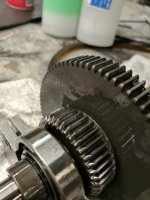Help! Low gear spindle noise
We have an early 90s VF that just "developed" a loud noise in the spindle.
We had an issue with our air compressor leaking, and had fixed that. We went to run our warm up and the machine was running fine when we realized the air was still turned off, run back to the compressor and flipped the switch, and we hear a nasty noise and realize the spindle tried to change gears, while running...
Now it sounds pretty rough running at S500, but fine at S2000.
Would like to point out that the machine was running-with no air-which is weird.
The spindle runs fine in high gear at any speed (S2000-7500), and in high gear at the low speeds (S2000 overridden to 10 or 20%), so high gear seems to be fine, as do the spindle bearings.
Did we toast the low gear cog, or bearing? Is something just loose? Is something jammed, or not seating correctly?
How do we check?
Any help would be much appreciated!
We have an early 90s VF that just "developed" a loud noise in the spindle.
We had an issue with our air compressor leaking, and had fixed that. We went to run our warm up and the machine was running fine when we realized the air was still turned off, run back to the compressor and flipped the switch, and we hear a nasty noise and realize the spindle tried to change gears, while running...
Now it sounds pretty rough running at S500, but fine at S2000.
Would like to point out that the machine was running-with no air-which is weird.
The spindle runs fine in high gear at any speed (S2000-7500), and in high gear at the low speeds (S2000 overridden to 10 or 20%), so high gear seems to be fine, as do the spindle bearings.
Did we toast the low gear cog, or bearing? Is something just loose? Is something jammed, or not seating correctly?
How do we check?
Any help would be much appreciated!




